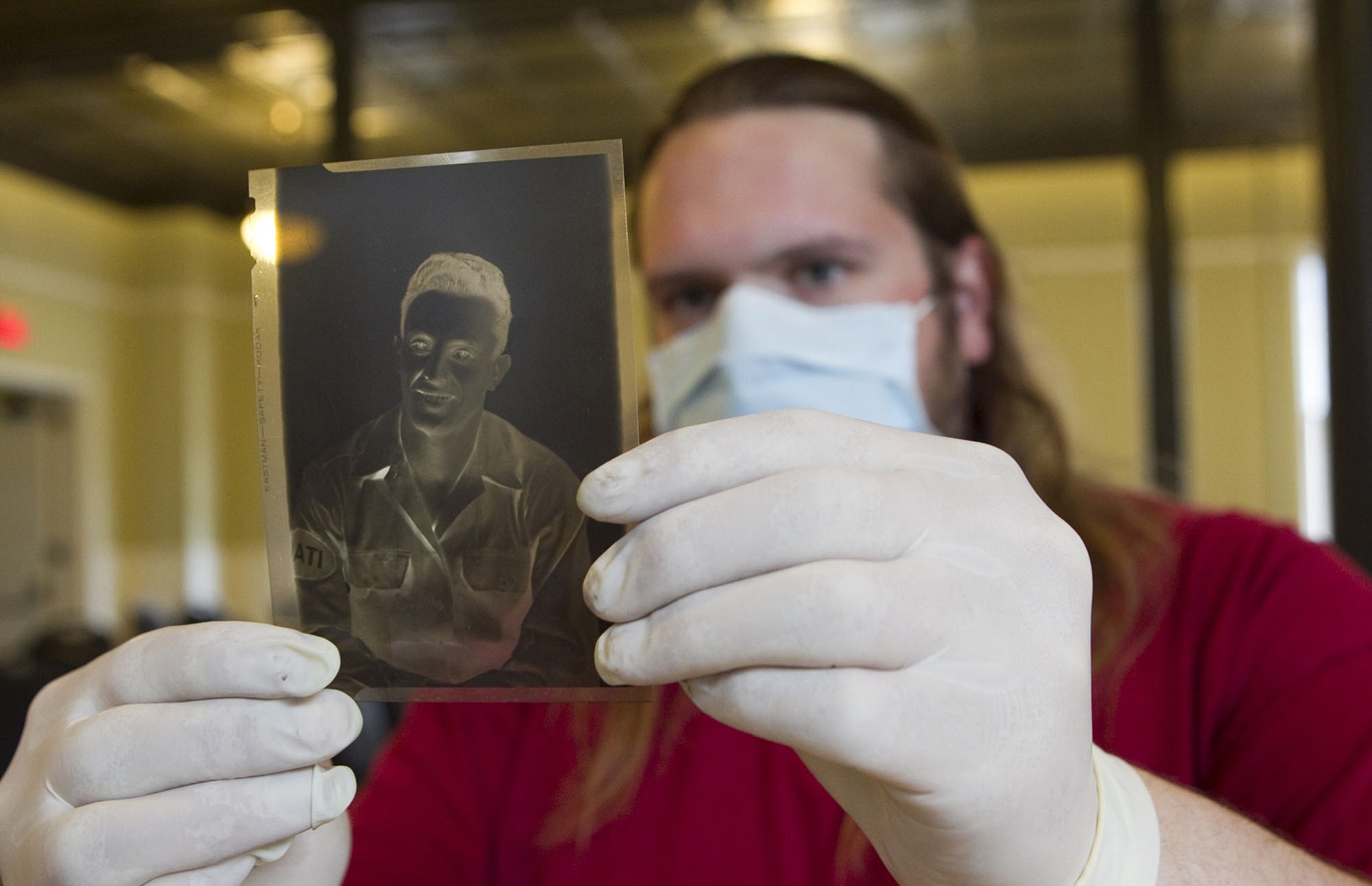Quartermaster Corps training at Vancouver Barrack prepared soldiers for World War II duty in supply, graves registration and food services. Another quartermaster category, called field services, included laundry companies that sometimes set up just beyond enemy artillery range during fighting in Europe.
With a devil-may-care smile and his hat at a jaunty tilt, he looks proud to answer his country’s call.
With carbine and helmet, he looks prepared to invade.
With ribbon-tied pigtails framing her furrowed face, she looks ready to pout.
It is December 1943, and America is marshaling its forces during World War II. Thousands of people are part of the mobilization at Vancouver Barracks. Most are soldiers, sent here from all over the country; a few are local civilians who work at the barracks.
And it is time for their photo appointments.
Seventy years later, hundreds of those faces returned to the former U.S. Army post. Their photographs were donated to the Vancouver Barracks Military Association, a nonprofit heritage group, by a Portland photographer.
A few association members gathered recently for a sorting session in the renovated Artillery Barracks building. Hundreds of black-and-white photos were arrayed on tables, illustrating men preparing for war and people on the home front supporting them. The faces even include some Italian soldiers who came to Vancouver as prisoners of war.
“These are the faces of World War II at Vancouver Barracks,” said Jack Giesen, treasurer of the military association. “These are the people who made history.”
Some turned their photo sessions into family portraits. An Army corporal sits next to a woman who likely is his wife, with an infant between them. The envelope labeled “Post Photo Shop” says the soldier is Thomas Walsh, medical section, BGH. That would be Barnes General Hospital, now part of the Vancouver Veterans Affairs medical campus, Giesen said. Walsh paid $6.50 for three 5-by-7-inch prints.
Major Barber’s girl
The photo of the little girl with the pigtails came from an envelope marked “Major Barber.”
That is typical of the information penciled on most of the envelopes. It’s pretty sketchy: maybe a last name and a unit designation.
A few have instructions for hand-tinting the black-and-white photos. The photo envelope for a woman in the finance office specified: brown hair, green eyes, fair complexion, white blouse.
Many of the soldiers are identified as members of Quartermaster Corps units.
“This was a quartermaster training post,” said historian Jeff Davis, president of the military association.
About 2,000 individuals are pictured in the photo cache, Davis said.
As Army veterans, Davis, Giesen and association secretary Chris Heagy looked at the photos through the eyes of former soldiers. A lot of the photo subjects don’t have any ribbons on their uniforms, someone observed. They’re new soldiers, in training.
Pointing to one firm-jawed black soldier, Heagy remarked: “This guy looks like my first sergeant.”
A few others stand out. The random display includes one member of the Women’s Army Corps, identified as Betty Thomason.
The helmeted soldier with the carbine is the only one who posed with a weapon. He is identified as C.L. Gardner.
Can’t let them rot
The cache was recently donated to the military association by Portland photographer Lenny Gotter.
“I actually rescued these pictures about 15 years ago,” Gotter said.
It happened during a renovation project in the Bullier Building in downtown Portland. After construction workers got into a ceiling space, they found “box after box of pictures, all from the same photographer,” Gotter said.
In addition to the Vancouver Barracks photos, there were other studio portraits and even some department-store catalogue shots.
“The building owner knew I was a photographer. I bought the lot for a couple hundred bucks. I’ve been sitting on it for years, not sure what to do with it,” Gotter said.
He contacted the Oregon Historical Society, and was told about Vancouver Barracks.
“I didn’t realize all the history that went with that,” Gotter said of the Army post established in 1849.
“I wanted the photos to go somewhere. I wasn’t going to let them rot. I could sell them on eBay but this is a historic find. I looked around the Internet and found the Vancouver Barracks Military Association,” Gotter said. “I would love to get them all scanned and all be available somewhere.”
That’s the association’s goal as well, Davis said.
“Ultimately, we’d like to make them available online, and people can look for family members,” Davis said.
Family contacts might also give archivists some information about the people captured in those photographs so long ago.
Meanwhile, Gotter can answer another question about the cache: Why are all those prints still here? Didn’t the customers pick up their photos?
“I’m sure they were paid for and picked up,” Gotter said. He figures the leftovers were a marketing effort by the photographer.
“He probably made extra prints. A guy would order two and he’d make three, in hopes that they would buy another.”




